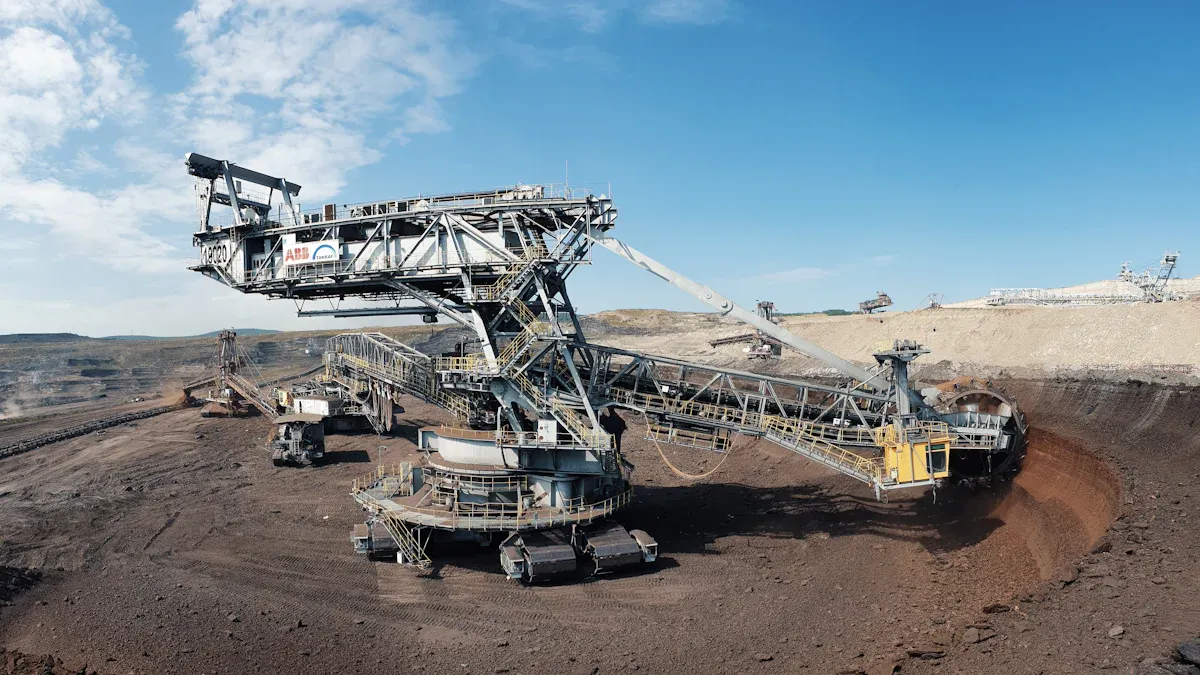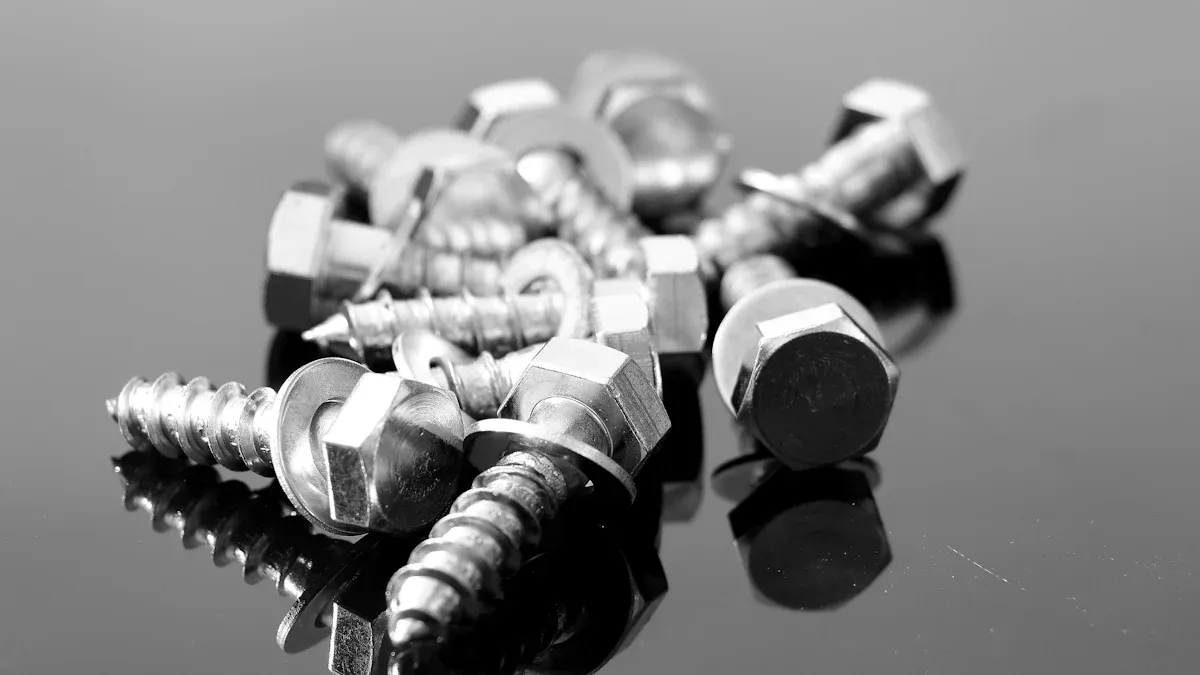
Sourcing mine-grade cutting edge bolts demands precision and strategic planning. These components, vital for mining and heavy machinery, must meet rigorous standards. Reliable distributors ensure a consistent supply of mine-grade section bolts, while quality assurance safeguards performance. Logistical planning optimizes costs and delivery timelines. Products like bucket tooth pins for mining excavators and high-wear bucket tooth pins require similar attention to detail during procurement, ensuring that all components, including mine-grade cutting edge bolts, are up to the task.
Key Takeaways
- Finding strong bolts for mining needs careful checks on materials, specs, and approvals to ensure they last and work well.
- Picking trusted sellers with good reviews and strong supply systems reduces problems and ensures fast delivery of good products.
- Using smart money-saving plans helps companies stay on budget while keeping parts high quality.
Understanding Mine-Grade Cutting-Edge Bolts

Definition and Characteristics
Mine-grade cutting-edge bolts are specialized fasteners designed to endure the extreme conditions of mining and heavy industrial operations. These bolts secure cutting edges and other wear components to machinery, ensuring stability and performance. Their construction typically involves high-strength materials, such as alloy steel, which provide exceptional durability and resistance to wear. Advanced manufacturing processes, including heat treatment and precision machining, enhance their mechanical properties.
Key characteristics of mine-grade cutting-edge bolts include:
- High tensile strength: Withstand heavy loads and intense vibrations.
- Corrosion resistance: Perform reliably in harsh environments, including exposure to moisture and chemicals.
- Dimensional accuracy: Ensure a precise fit for seamless integration with equipment.
These features make them indispensable for maintaining the efficiency and safety of mining equipment.
Applications in Mining and Heavy Industries
Mine-grade cutting-edge bolts play a critical role in various applications across mining and heavy industries. In mining, they secure cutting edges on excavators, loaders, and bulldozers, enabling these machines to handle abrasive materials like rock and ore. They also fasten wear plates and other protective components, extending the lifespan of equipment.
In heavy industries, such as construction and quarrying, these bolts are used in machinery that processes raw materials. Their ability to withstand high stress and wear ensures uninterrupted operations, reducing downtime and maintenance costs. For example, Ningbo Digtech (YH) Machinery Co., Ltd. supplies bolts that meet the rigorous demands of these industries, ensuring reliability and performance.
Key Specifications to Consider
Selecting the right mine-grade cutting-edge bolts requires careful evaluation of key specifications. These include:
- Material composition: High-quality alloy steel or equivalent materials provide the necessary strength and durability.
- Thread type and size: Compatibility with equipment specifications ensures a secure fit.
- Coating and finish: Anti-corrosion coatings, such as zinc plating, enhance longevity in harsh environments.
- Performance metrics: Metrics like wear resistance, tool life, and fracture toughness define the efficiency of these bolts.
The following table highlights critical performance metrics:
| Metric | Description |
|---|---|
| Wear Resistance | Improved wear resistance in tough abrasive conditions, enhancing tool longevity. |
| Tool Life | D Power™ Road Picks can exceed 40 times the life of standard carbide picks, boosting productivity. |
| Fracture Toughness | Premium Grade T6 inserts improve tool consistency and reduce failures, maintaining operational efficiency. |
| Cost-Effectiveness | Enhanced materials lead to reduced maintenance costs and operational downtime, improving overall efficiency. |
By considering these specifications, businesses can ensure they source bolts that meet operational demands and deliver long-term value.
Identifying Reliable Global Distributors
Sourcing mine-grade cutting edge bolts from reliable distributors ensures consistent quality and uninterrupted operations. Identifying trustworthy suppliers requires evaluating their certifications, reputation, and supply chain capabilities. These factors help businesses make informed decisions and mitigate risks in procurement.
Certifications and Credentials
Certifications validate a distributor’s adherence to industry standards and regulatory requirements. They demonstrate the distributor’s commitment to quality and compliance, which is essential when sourcing mine-grade cutting edge bolts for demanding applications. Distributors with recognized certifications provide assurance that their products meet stringent performance and safety criteria.
The following table highlights key certification standards and their significance:
| Certification Standard | Description |
|---|---|
| ISO 17025 | Accreditation for testing and calibration services. |
| ANSI Accreditation | Compliance with ISO/IEC 17065 and TCB schemes. |
| FCC Designation | Recognition as a Telecommunications Certification Body (TCB) by the FCC. |
| ISED Canada Recognition | Approval by Innovation, Science, and Economic Development Canada. |
| NIST Recognition | Expanded recognition for global compliance by NIST. |
| EU Notified Bodies | Listing in EU directories for regulatory compliance. |
Distributors like Ningbo Digtech (YH) Machinery Co., Ltd. often maintain such certifications to ensure their products meet global standards. Businesses should prioritize suppliers with these credentials to guarantee the reliability of their bolts.
Reputation and Industry Experience
A distributor’s reputation reflects its reliability and ability to deliver high-quality products consistently. Companies with extensive experience in the mining and heavy machinery sectors understand the unique challenges of these industries. They are better equipped to provide solutions tailored to specific operational needs.
When evaluating a distributor’s reputation, businesses should consider:
- Customer reviews and testimonials: Positive feedback from clients indicates trustworthiness.
- Case studies: Examples of successful projects demonstrate the distributor’s expertise.
- Longevity in the industry: Established suppliers often have proven track records.
For instance, distributors with decades of experience in supplying mine-grade cutting edge bolts are more likely to offer products that withstand harsh conditions. Their familiarity with industry trends and requirements ensures they can meet evolving demands.
Supply Chain Network Strength
A robust supply chain network ensures timely delivery and availability of products, even during disruptions. Distributors with strong logistics capabilities can manage inventory efficiently and minimize lead times. This is particularly important for mine-grade cutting edge bolts, which are critical for maintaining operational continuity.
Key indicators of a strong supply chain include:
- Global reach: Distributors with international networks can source and deliver products across regions.
- Inventory management: Adequate stock levels reduce the risk of delays.
- Partnerships with manufacturers: Close ties with producers ensure consistent supply and quality.
Ningbo Digtech (YH) Machinery Co., Ltd., for example, leverages its extensive supply chain to provide reliable and timely delivery of bolts to clients worldwide. Businesses should prioritize distributors with similar capabilities to avoid disruptions and maintain efficiency.
Ensuring Quality and Compliance
Industry Standards for Mine-Grade Cutting Edge Bolts
Industry standards ensure that mine-grade cutting edge bolts meet the rigorous demands of mining and heavy industries. These standards define the mechanical properties, material composition, and performance benchmarks required for these bolts. Organizations such as ISO and ASTM establish guidelines that manufacturers and distributors must follow to ensure product reliability.
For example, ISO 898-1 specifies the mechanical properties of fasteners made from carbon steel and alloy steel, ensuring their strength and durability. Adherence to such standards guarantees that bolts can withstand extreme conditions, including high stress and abrasive environments. Businesses sourcing these bolts should prioritize suppliers who comply with these globally recognized standards.
Quality Assurance Processes
Effective quality assurance processes are critical for maintaining the performance and safety of mine-grade cutting edge bolts. Manufacturers implement rigorous testing protocols to verify the bolts’ tensile strength, wear resistance, and dimensional accuracy. These tests often include load testing, hardness testing, and corrosion resistance evaluations.
Distributors like Ningbo Digtech (YH) Machinery Co., Ltd. ensure that their products undergo thorough inspections at every stage of production. This commitment to quality minimizes the risk of equipment failure and operational downtime. Additionally, compliance benchmarking helps evaluate a company’s quality assurance program against industry standards. It identifies strengths and areas for improvement, ensuring that processes remain effective and up-to-date.
Compliance with Regulations
Compliance with regulations safeguards businesses from legal and operational risks. Companies must adhere to local and international laws governing the production, distribution, and use of mine-grade cutting edge bolts. Key performance indicators (KPIs) help measure compliance success, as shown in the table below:
| KPI | Description |
|---|---|
| Regulatory Compliance Rate | Measures adherence to applicable laws and regulations, helping gauge legal standing. |
| Policy Adherence | Assesses the percentage of employees following internal policies, mitigating non-compliance risks. |
| Incident Reporting and Response Time | Measures the time taken to report incidents and respond, minimizing compliance breach impacts. |
| Training Completion Rate | Monitors the completion rates of compliance training programs, ensuring employees are informed. |
By monitoring these KPIs, businesses can ensure their operations align with regulatory requirements. A strong compliance program reduces risks and enhances operational efficiency, making it a cornerstone of successful procurement strategies.
Navigating Logistics and Costs

Shipping and Handling Considerations
Efficient shipping and handling play a pivotal role in the global distribution of industrial components. Businesses must evaluate transportation modes, packaging requirements, and delivery timelines to ensure seamless operations. Proper packaging protects bolts from damage during transit, while optimized shipping routes reduce delays. Companies should also consider freight consolidation to minimize costs and improve efficiency.
For instance, transportation cost estimates help businesses choose the most cost-effective shipping methods. Non-transport logistics costs, such as warehousing and inventory management, also impact overall expenses. Evaluating these factors ensures that mine-grade cutting edge bolts reach their destination in optimal condition.
Import/Export Regulations
Navigating import/export regulations requires a thorough understanding of international trade laws. Compliance with customs documentation, tariffs, and trade agreements ensures smooth cross-border transactions. Businesses must stay updated on regulatory changes to avoid penalties and delays.
Partnering with distributors experienced in global trade, such as Ningbo Digtech (YH) Machinery Co., Ltd., simplifies this process. Their expertise in handling customs procedures and certifications ensures that products meet all legal requirements. This reduces the risk of non-compliance and enhances operational efficiency.
Cost Management Strategies
Effective cost management strategies help businesses optimize their budgets while maintaining quality. Companies can analyze fixed, variable, and step-fixed costs to identify areas for improvement. For example, leveraging technology reduces unit costs, while group purchasing lowers procurement expenses.
The table below highlights key cost behaviors and strategies:
| Main Cost Behaviors | Direct | Indirect |
|---|---|---|
| Fixed | Scrub expenses, scale up, explore shared facilities | Diversify client base, re-centralize services, consider outsourcing |
| Variable | Leverage technology, encourage cash contributions, improve workflow | Group purchasing, decentralize services, enhance planning |
| Step-Fixed | Increase staffing ratios, set enrollment caps, employ waitlists | Narrow service scope, stagger enrollments, use technology to reduce costs |
By implementing these strategies, businesses can achieve financial stability and operational efficiency. Monitoring operational, liquidity, and profitability metrics further supports informed decision-making.
Sourcing high-quality mine-grade cutting-edge bolts ensures operational efficiency and equipment longevity. Reliable distributors with strong credentials and robust supply chains play a pivotal role. Adhering to specifications and planning logistics effectively minimizes risks.
Tip: Research distributors like Ningbo Digtech (YH) Machinery Co., Ltd., verify certifications, and ensure compliance with industry standards to streamline procurement.
FAQ
What are mine-grade cutting-edge bolts made of?
Mine-grade cutting-edge bolts typically use alloy steel for durability and wear resistance. Manufacturers enhance their properties through heat treatment and precision machining.
How can businesses verify bolt quality?
Businesses can verify bolt quality by checking certifications, conducting tensile strength tests, and ensuring compliance with ISO and ASTM standards.
Why is corrosion resistance important for these bolts?
Corrosion resistance ensures bolts perform reliably in harsh environments, reducing maintenance costs and extending equipment lifespan.
Post time: May-20-2025